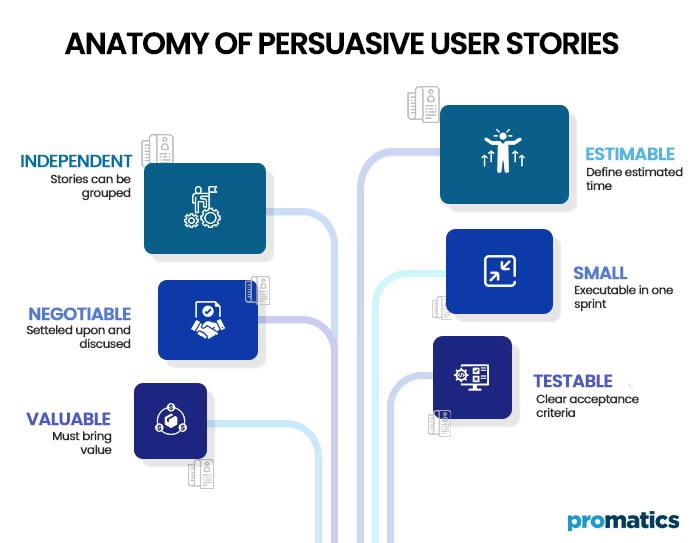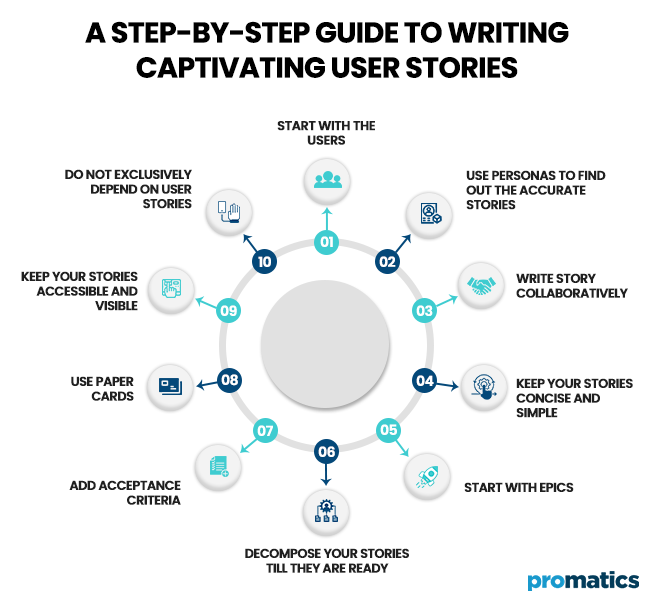The Art of Writing User Stories: App Edition
App development is a challenging task that involves various complexities in the planning, development, and testing phases. It often takes a significant amount of time to achieve the desired result. However, adopting agile user stories becomes essential to provide real value to your end-users and improve your overall business efficiency.
Adopting user stories is a transformative step toward building a user-centric and agile company. This approach helps you better understand your users, leading to significant enhancements in your key performance indicators (KPIs). To ensure your success, following a few essential techniques when crafting user stories for your app is important. Let us guide you through the best practices for writing impactful user stories for your app.
What are user stories in Agile?
In Agile software development, user stories are utilized to capture the requirements of a software system from the customer’s perspective. User stories are concise, straightforward, and non-technical depictions of desired features, functionalities, or workpieces. The narrative describes the type of user, their needs, and the reasons behind those needs. It provides a simplified description of a requirement.
User stories are commonly documented on Post-it notes, index cards, or project management software. Depending on the project, multiple stakeholders, including users, customers, managers, or development team members, may contribute to writing the user story.
Why create user stories?
- User stories ensure a customer-centric approach to software development.
- They help prioritize features based on user value and business goals.
- The Agile user stories promote flexibility and adaptability in development.
- They provide a basis for testing and validation.
- User stories help the development team understand users’ needs, preferences, and pain points.
- Serve as a common language for discussing and agreeing upon desired functionality.
- Assist in planning iterations or sprints to deliver high-value features early.
- User stories provide a basis for defining acceptance criteria and ensuring the software meets user expectations.
- User stories make the software more user-friendly through a user-centered design approach.
- Managing stakeholder expectations makes the development process more transparent.
Features of compelling user stories
When crafting a user story, it is crucial to include the following information to maintain a professional and practical approach:
i.) Description or Summary: Provide a concise yet comprehensive overview of the feature that aligns with the business requirement.
ii.) Acceptance Criteria: Clearly define the necessary actions that must be completed for the user story to be considered “done.” These criteria should adhere to the established Definition of Done (DoD).
iii.) Additional Items: Depending on the team’s preferences and chosen tool (e.g., Azure DevOps, JIRA, Rally), include any other relevant details such as labels, epics, or supplementary information recognized by the team.
Following the best practices of product management, an ideal user story should fulfill the criteria represented by the acronym INVEST, which stands for:
Independent: Although stories can be grouped and prioritized, each user story should be self-contained and independent. The team should be able to work on each level in any order without dependencies.
Negotiable: User stories should be open to discussion and collaboration between the consumers and product owners. They should accommodate the interests and perspectives of both parties.
Valuable: User stories must deliver value to clients and the team. They should address the needs and expectations of the users while contributing to the project’s overall objectives.
Estimable: It should be feasible for the team to estimate the time and effort required to complete each user story accurately. This allows for effective planning and resource allocation.
Small: Each user story should be small enough to be completed within a single sprint. It promotes better visibility and progress tracking during the development process.
Testable: User stories should have specific acceptance criteria that enable the quality assurance (QA) team to test and verify if the implemented functionality aligns with the expectations of the stakeholders and users.
Breaking down the delivery increment into separate user stories allows the team to assign tasks, estimate, size, and test each component effectively. The product owner works closely with the team to prioritize functionality according to user needs.
How to write compelling user stories?
Start with the users
User stories should be written from the perspective of the client or user. Capture the user’s experience and focus on specific functionalities they need. Basically, it depends on the type of application you are developing.
Utilize personas
Personas can be valuable in understanding your users and customers. Identify the objectives of each persona and determine the functionalities that align with those objectives.
Collaborative writing
User stories are not specifications but tools for collaboration and communication. Involve the development team in the conversation and writing process. Their input and creativity often result in better user stories.
Keep it concise and straightforward
Write user stories clearly and straightforwardly. Avoid ambiguity, confusing terms, and passive voice. Focus on what is essential and exclude irrelevant information. Experiment with different writing approaches to find what works best for your team.
Start with epics
Epics are high-level user story groups that help define the overall functionality of a product without getting too detailed. This is particularly useful for new products and features, allowing you to understand user requirements and scope while minimizing the effort needed for updates.
Decompose stories
Break down epic stories into more minor, more manageable levels. Ensure that everyone understands the essence of each story and they are brief and concise. Establish clear criteria for when a story is considered complete.
Include acceptance criteria
As you decompose epics into smaller stories, incorporate acceptance criteria. These criteria describe the conditions for an account to be finished. They make the story more specific, testable, and verifiable to users and stakeholders. Aim for three to five acceptance criteria for each story.
Use paper cards
Paper cards are cost-effective and promote collaboration. Each team member can write their ideas on a card, which can be easily organized and visualized on a table or wall. Even if stories are stored electronically, starting with paper cards can be beneficial.
Keep stories accessible and visible.
User stories should be easily accessible to the team. Avoid burying them on internal platforms or licensed tools. Consider displaying them on a wall or using tools like Product Canvas to facilitate your stories’ discovery, visualization, and management.
Do not exclusively depend on user stories
While writing user stories is valuable, it is essential to consider other aspects of creating a great user experience (UX). It analyzes user journeys, interactions, visual design, and nonfunctional properties. By taking a comprehensive approach, you can better identify risks, assumptions and increase the likelihood of delivering a product with the desired user experience.
Examples of user stories and templates
User Story template
The user story template provides context for writing user stories for the Agile development team. It expresses the “who,” “why,” and “what” aspects related to an item of Agile development.
With the help of a user story template, it is easier to clearly understand the value a specific feature holds for the client. The most commonly used template format for a user story is: “As a (user), I want to (capability), so that (receive the benefit).” This template is concise and straightforward and allows for quick composition. The concept can be applied to various products and even tailored to specific user types. Let’s delve into the details of this template.
As a (user): The user refers to the individual for whom the product is being developed. It is crucial to deeply understand this person – their thoughts, actions, and work patterns. This understanding informs the subsequent part of the template.
I want to (capability): This describes the user’s expectation from the feature being developed. It represents the user’s objective that you aim to fulfill. Therefore, a clear comprehension of the desired outcome is necessary.
So that (receive the benefit): This is the essence of the matter. It highlights the tangible benefit the user seeks to gain from the specific feature or the problem for which the user seeks a solution.
This template lets developers know the target audience and the context or expectation. The team comprehends what they need to accomplish, and ultimately, they understand the advantage or solution they are supposed to offer the user.
User Story examples
To better understand what a user story is, here are some examples.
- As a new credit card user, I want to understand all the features and advantages of the card to benefit from it entirely.
- As a data administrator, I want to consolidate data from various sources for easier report generation.
- As a team leader, I want to receive automatic alerts when my team encounters obstacles so that I can provide immediate assistance.
- As a new user, I want the option to sign in with my Google account, eliminating the need for multiple accounts.
- As a new subscriber to this service, I want a guided tour of all its features to ensure I can utilize them effectively.
- As an HR manager, I want a consolidated view of daily attendance for all staff members, enabling easy monitoring of their punctuality.
- As a frequent visitor to your website, I want to receive notifications whenever a new product is introduced or added so that I can review them.
- As a shop owner, I want an accurate inventory management system to track stock levels and determine when to reorder specific items.
- As a user of this service, I want to receive mobile notifications to stay updated even while on the go.
- As a frequent traveler, I want access to a migratory route map for convenient navigation.
These are some examples of User Stories. You can see, in every story, a user either wants a solution otherwise some new feature that would make their life easy.
Conclusion
User stories play a massive part in agile software development. They deliver a framework for the team to work on that puts the end user at the center of the conversation. Also, by dividing the product into these components, the teams better understand the context of every feature. Writing and implementing user stories promotes communication and collaboration between all parties, improving the productivity and quality of the product.
FAQs
When should a user story be created?
User stories are typically created at the beginning of an Agile project. Conducting a story-writing workshop early on in the project’s Agile lifecycle is common.
Why use user stories in Agile?
In agile software development, user stories help articulate what value a product feature can bring and have a better understanding of why users want solid functionality. It aids the product manager and development team move their focus from writing about the software features to discussing them.
What is the key component of a user story?
The central element of a user story is its goal. Goals represent the actions that a company intends its target audience to take. If the company lacks a clear understanding of the processes that drive these primary actions, the product may not function effectively.
What questions should I ask when creating user stories?
When creating user stories, it is important to ask specific questions to gather the necessary information and ensure clarity. Here are some common questions to consider:
- What specific tasks or actions should the app enable the user to perform?
- Why is this functionality important or valuable to the user?
- Are there any specific platforms or devices the app should support?
- Are there any specific performance or security requirements?
- What are the desired user interface and user experience (UI/UX) considerations?
- Are there any specific integration points with other systems or services?
- Are there any legal or compliance requirements that need to be considered?
- What are the expected performance or scalability requirements?
These questions will help you gather the necessary details and ensure that the user stories for app development effectively capture the requirements and expectations for the project.
Who writes user stories?
User stories can be written by various stakeholders involved in Agile software development. This includes users, customers, managers, or development team members. Depending on the project, multiple individuals with different perspectives and roles may contribute to writing user stories. However, it is typical for the Scrum team to collaborate with the product owner to create these stories.
Why is it called a user story?
Users or clients write user stories to influence the functionality of the system being developed. These stories capture the desired functionality and features from a user’s point of view. In many teams, the responsibility for crafting user stories and organizing them into a product backlog lies with the product manager or owner. They play a crucial role in understanding and translating user requirements into actionable user stories that guide the development process.
Why are user stories necessary?
User stories are essential as they enable developers to understand the product’s anticipated user value and understand the specific needs to be addressed by the team. The primary objective of user stories is to simplify the essential core of the project and outline the fundamental requirements necessary to make it usable.
Still have your concerns?
Your concerns are legit, and we know how to deal with them. Hook us up for a discussion, no strings attached, and we will show how we can add value to your operations!


